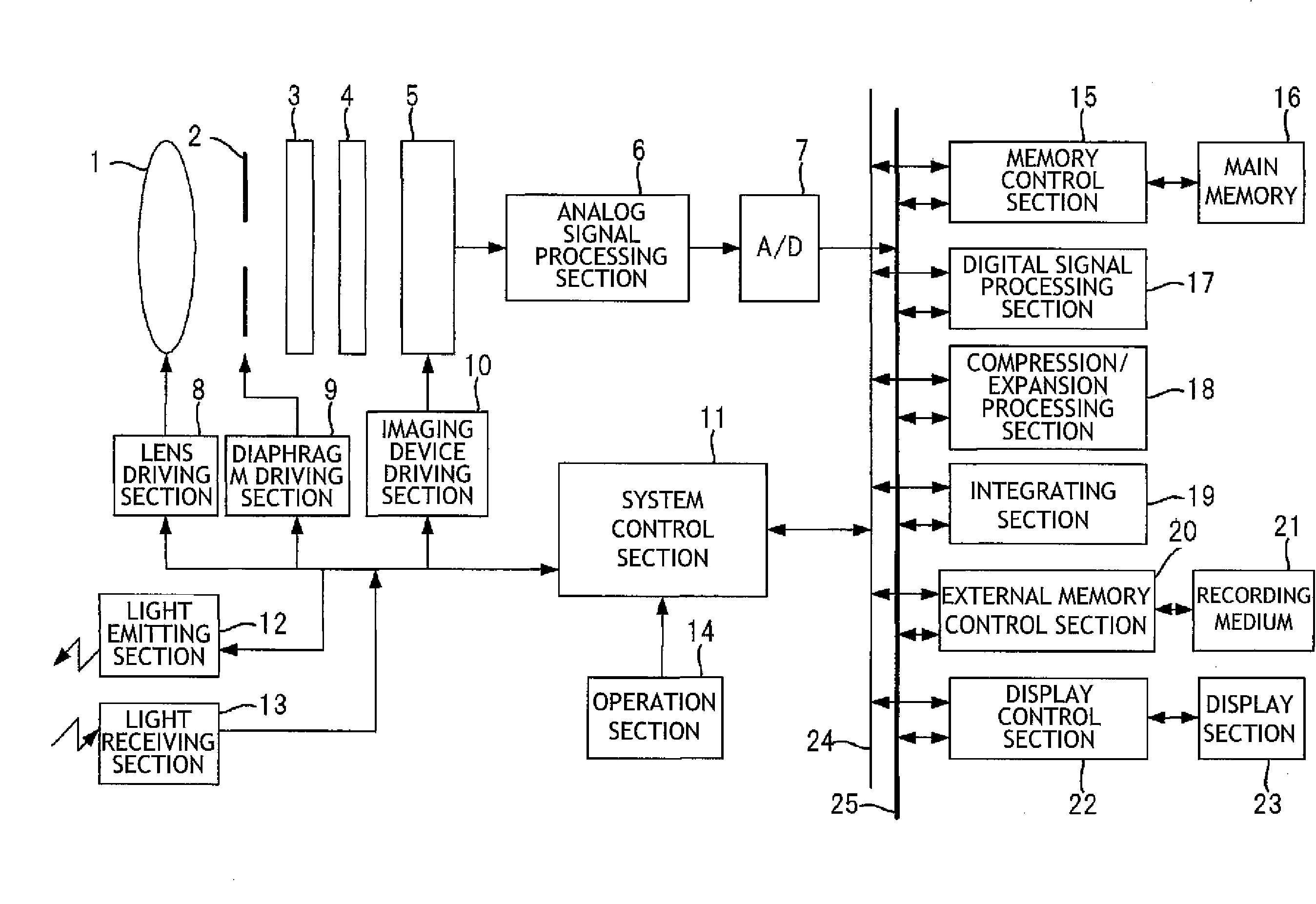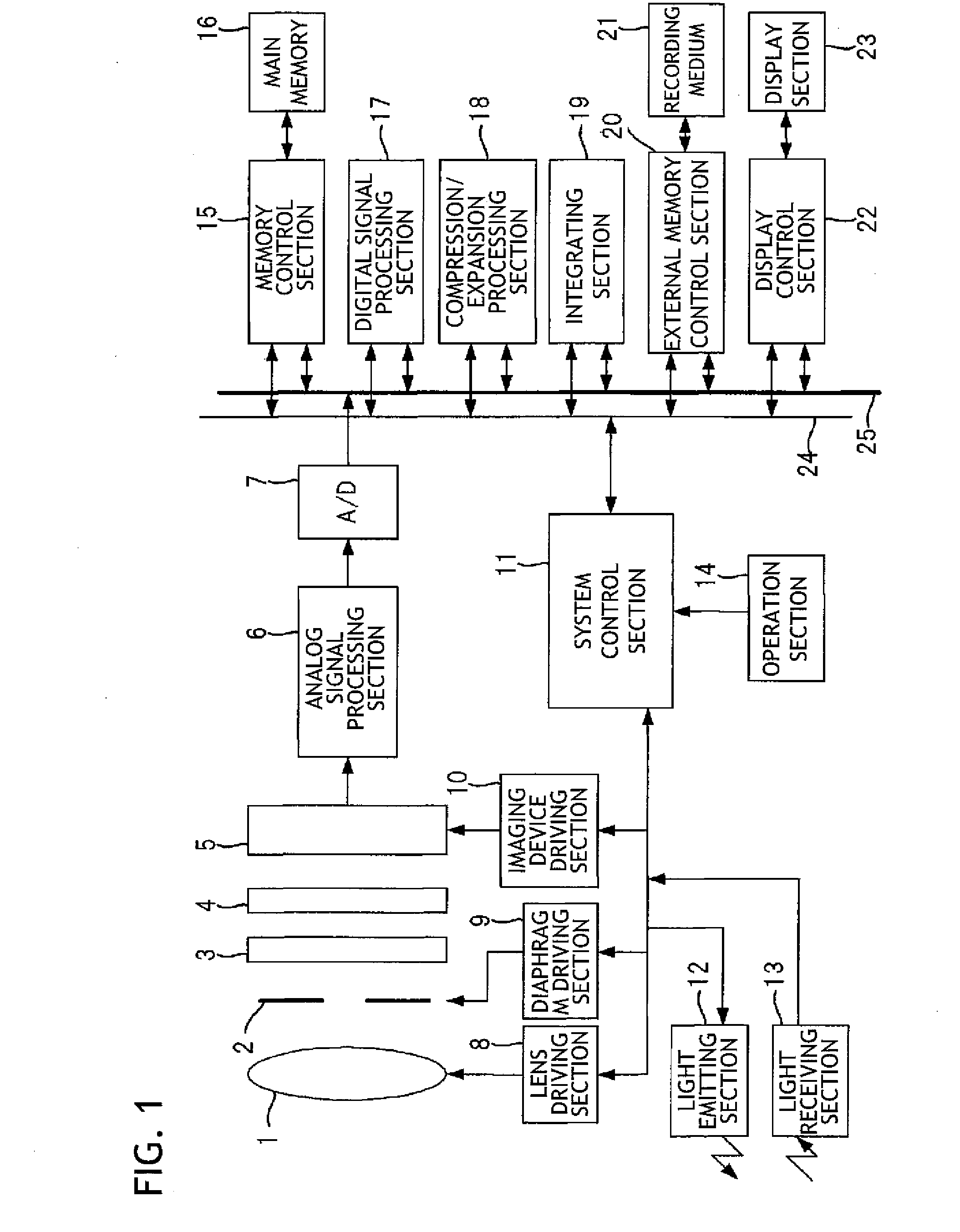Imaging apparatus and method for driving solid-state imaging device
- Summary
- Abstract
- Description
- Claims
- Application Information
AI Technical Summary
Benefits of technology
Problems solved by technology
Method used
Image
Examples
first embodiment
[0026]FIG. 1 is a view showing an outline of the configuration of a digital camera that is an example of an imaging apparatus with reference to which a first embodiment of the invention will be described.
[0027]A taking-image system of the digital camera shown in the figure includes a taking lens 1, a solid-state imaging device 5, an aperture diaphragm 2 which is arranged between the taking lens 1 and the solid-state imaging device 5, an infrared cut filter 3; and an optical low-pass filter 4.
[0028]A system control section 11 for controlling the entire electric controlling system of the digital camera controls a flash light emitting section 12 and a light receiving section 13. The system control section 11 also controls a lens driving section 8 so as to adjust a position of the taking lens 1 to a focusing position and to adjust zooming. Furthermore, the system control section 11 controls the aperture diaphragm 2 through a diaphragm driving section 9 so as to adjust an exposure amount...
second embodiment
[0063]The configuration of a digital camera explained according to a second embodiment is the same as that shown in FIG. 1 and therefore will be described with reference to FIGS. 1 and 2.
[0064]The photographing operation of the digital camera of this embodiment will be described below. FIG. 4 is a flow chart showing an operation executed at a time of photographing with the digital camera of the second embodiment.
[0065]When a shutter button provided in the operation section 14 is half-pressed (step S1), the system control section 11 performs the automatic exposure process (AE) (step S2) and the automatic focus adjustment process (AF) (step S3), and also measure a dynamic range necessary for photographing a photographic object (step S4). The system control section II determines an exposure time for the photoelectric conversion element 51R, 51G, 51B and an exposure time for the photoelectric conversion element 51r, 51g, 51b based on the measured dynamic range and controls the imaging d...
third embodiment
[0077]In the first and second embodiments, the photoelectric conversion elements of the solid-state imaging devices 5 are arranged in a so-called honeycomb arrangement in which an rgb group of photoelectric conversion elements and an rgb group of photoelectric conversion elements are shifted in the row direction X and the column direction Y by ½ of the arrangement pitch. However, the arrangement of the photoelectric conversion elements is not limited to this specific example. For example, the photoelectric conversion elements may be arranged in a square grid. In this embodiment, another configuration example of the solid-state imaging device will be described.
[0078]FIG. 6 is a schematic plan view showing another example of the configuration of the solid-state imaging devices mounted on the digital camera shown in FIG. 1.
[0079]A solid-state imaging device 5′ shown in FIG. 6 includes an RGB group of photoelectric conversion elements and an rgb group of photoelectric conversion element...
PUM
 Login to View More
Login to View More Abstract
Description
Claims
Application Information
 Login to View More
Login to View More - R&D
- Intellectual Property
- Life Sciences
- Materials
- Tech Scout
- Unparalleled Data Quality
- Higher Quality Content
- 60% Fewer Hallucinations
Browse by: Latest US Patents, China's latest patents, Technical Efficacy Thesaurus, Application Domain, Technology Topic, Popular Technical Reports.
© 2025 PatSnap. All rights reserved.Legal|Privacy policy|Modern Slavery Act Transparency Statement|Sitemap|About US| Contact US: help@patsnap.com



